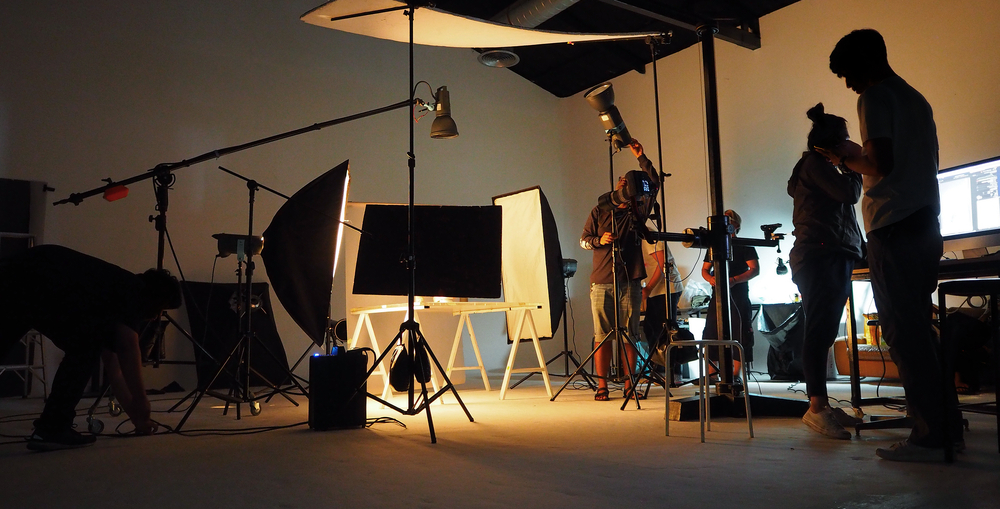
Learn what a videographer does and how to enter the market
Learn about all the stages of a video maker’s work!

Currently, video is the format most used by companies to promote their products, share content, and especially, interact with their consumers.
Although it is completely possible to produce quality amateur videos, relying on a professional like a videographer can make all the difference.
The way people consume content has changed over the years. And the popularity of videos, along with the emergence of platforms that facilitate their distribution, has contributed to this.
This reflects directly on how videographers work, since they always need to pay attention to new formats, styles, and any type of innovation surrounding the audiovisual field to stay tuned to the market.
We’ve prepared this post to help you understand what videographers do and how to become one. Keep reading to learn everything you need to know!
Who are videographers and what do they do?
As we’ll explain below, videographers don’t just shoot videos; they take part in all steps of the video creation process.
Pre-production
Pre-production is the process of planning the entire video project. The whole team, including the videographer, will decide on the best approaches for the production to go as planned.
Below, you’ll find the activities performed by a videographer during the pre-production process:
Participates in brainstorming meetings
Brainstorming is when the team explores different ideas and concepts to produce the video.
Everyone gives suggestions based on their research to start developing the production.
Helps prepare the briefing
Immediately after brainstorming comes the briefing.
Here, the videographer and the team exchange information and put together the development structure for the video production.
This is also when each person’s duties on the set will be determined.
Selects equipment needed in the scenes
The videographer is responsible for determining what equipment and items will be used for each scene of the video.
Then, the videographer must send the list to the financial department to handle the necessary purchases and rentals.
Creates the script
Creating a script is one of the most critical tasks during pre-production.
Scripts contain all the written text for the video and instructions for the production processes to run smoothly.
The script must be well structured for the success of the video.
Production
Production is the practical part of creating a video.
The videographer will take care of everything according to the script and prepare everything on set for filming, from setting up the cameras to the lighting.
Here’s what’s involved in the production process:
Filming
When it’s time to film, the videographer’s role is to make sure everything is in order.
They make sure that the lines, camera movements, audio, cues, and other essential aspects for filming go as planned.
And, of course, always in accordance with the script.
Directing
Despite being responsible for directing the scenes, the videographer doesn’t work alone. The entire team present on the recording set will help with directing.
The reason for this is that, as competent as the professional may be, possible mistakes and other details might go unnoticed.
Thus, the rest of the team, who will also be paying close attention to everything, will be able to identify any mistakes that arise and help the videographer to maintain the quality of the production.
And during these moments, they decide if the best approach is to shoot the scene again or not and change other set details.
Post-production
It’s unlikely that a video will be ready without requiring any editing, and that’s where post-production comes in. Post-production is when the raw footage recorded in the previous steps will be edited into the final video.
At this time, the videographer finishes the project, ensuring that the final video is aligned with everything that was planned and its objective.
During post-production, a videographer’s duties include:
Taking down the set
Immediately after filming is finished and before starting post-production, the videographer will take down the filming set together with the team.
This includes properly putting away all materials used, such as cameras, reflectors, microphones, and other items.
Video editing
Editing is when the videographer makes cuts, treats the audio, and adds any extras and special effects. They transform everything that was done during filming into a single file concisely and harmoniously.
The other people responsible for the technical execution of the filming are also part of this step.
For the final product to be consistent with everything that was planned and filmed, the videographer will always have the script at hand. This way, they’ll avoid any mistakes during post-production that could compromise the project.
Exporting the content
Finally, once post-production is finished, the video is ready to be shared with its audience.
Before releasing the finished work, the videographer needs to recheck the video one last time to make sure that everything is, in fact, in order.
With the script at hand, they analyze the video, watching it a few times until they are sure it’s ready to be released.
To further guarantee that everything went according to plan, other team members may also watch the final video.
They make sure that nothing goes unnoticed. Finally, the video is exported and released when everything is in order.
What kind of software does a videographer use?
Like all other creative professions, videographers also need to know different ways of doing their job. Hence, having several references and, above all, sound technical knowledge of their field of work.
Editing, which was mentioned above, the capturing of images, handling of the equipment, audio treatment, and other steps pertaining to audiovisual production, need to be part of this professional’s skill set.
To carry out each one of these steps efficiently and correctly, they need to know how to use a few programs:
- For treating images, Lightroom and Photoshop are the most commonly used programs;
- For video editing, Adobe Premiere, Final Cut, and Sony Vegas are favorites;
- And if there’s a need to insert motion designs and special effects into the project, the best programs are Illustrator and After Effects.
In certain situations, professionals are required to have an educational background to learn how to work with this software. However, it’s possible to learn how to use them without formal education.
The difference between a videographer and a filmmaker
So far, you’ve learned about the work of videographers.
Within the audiovisual segment, other professionals also work to create videos but go by different names.
That’s the case with videographers and filmmakers. Overall, they do practically the same thing, with the main difference between the scale of their work.
A videographer is usually a video creator who works in agencies or companies with a reduced team and resources. It’s very common for the team to accumulate duties.
For example, a videographer has a team consisting of 10 people, where all of them will be responsible for all the pre- and post-production processes.
On the other hand, filmmakers often have filmmaking degrees and usually work on large film projects. Therefore, they count on a lot more resources to work with.
Each production step of the film, from creating the script to its completion, is carried out by different teams.
What is the market for videographers like?
With the high demand for videographers in all sectors, it’s crucial to understand how the job market works. However, before diving into the subject, we should mention right away: the market is very promising for videographers.
Even so, it’s very competitive, even more so with the boom of the internet and specific social networks for sharing videos, such as YouTube and TikTok. Ease of access to video editing software also helps increase competitiveness.
Regardless, specialized videographers are valued on the job market.
According to the Video Marketing Statistics 2021 survey conducted in December 2020 by Wyzowl, 86% of businesses use video as a marketing strategy tool. And get this:
- 86% said they saw increased traffic on their sites;
- 87% of marketers said video helped them generate a good return on investment.
These numbers lead us to believe that opportunities for the profession are following the growth of video consumption on the internet. Next, we’ll discuss the current average salary for videographers.
Salary
The average salary for a videographer can vary greatly, depending on experience and qualifications. According to salary.com, salaries for videographers in the U.S. usually range between $56,304 and $85,058, with the average salary being $68,261.
Field of work
Videographers have a lot of options when it comes to specialization. They don’t need only to be involved in video production; for example, they can specialize in other areas of digital marketing and scriptwriting.
In digital marketing, considering the rise of audiovisual content on social networks, they can create promotional videos.There are increasingly more options for video production in marketing strategies: sales videos, vignettes, and many more.
Another option is producing videos for YouTube, which is growing, and with it, the demand for skilled professionals. Videographers can help with scriptwriting, video production, and editing for YouTube channels in all sorts of niches.
Beyond that, videographers can work with TV production, which is very common and desired by professionals in the field. The reason is that there are many opportunities to work with variety shows, documentaries, soap operas, series, and even news programs.
Main trends for videographers
To discuss the main trends, you need to keep something in mind: there are opportunities both on the internet and in traditional media. After all, TV is still part of many people’s daily routine.
So, to become a great professional, you should study aspects such as storytelling, production of short videos, and SEO. Understand more below.
Storytelling
Storytelling is the ability to tell stories, and it’s not just limited to those who work with books. Visual storytelling is crucial for videographers.
When a project involves writing a scriptwriter, they are expected to bring storytelling to the production. The images may be of good quality, but it’s the story told that sticks in the audience’s mind.
In other words, video is an excellent complement to storytelling, and that’s why you need to be careful. An audiovisual production can make the mistake of contradicting the story being told, and that should never be the objective of any business.
So, a good narrative accompanied by video should:
- capture the audience’s attention;
- be coherent;
- awaken emotions;
- promote dialog;
- be relatable to the audience and capable of creating connections;
- have a beginning, middle, and end.
Storytelling is also valuable for digital marketing, as it seeks to educate, attract, promote, win over customers, and build customer loyalty. A good tip is integrating customers and presenting a solution without necessarily selling a product or service.
Short videos and stories
With the rise of TikTok and Snapchat, Instagram Stories, Reels, and YouTube Stories, short videos have become a necessity for many businesses. Short videos make it possible to deliver a message in just a few seconds.
These short videos can capture users’ attention, but creativity needs to be prioritized during the video production process. It’s a good idea to produce straightforward content without necessarily relying on a big production.
The objective here is to educate and tell short stories – as we discussed in the previous topic.
The 10 Best Apps For Recording And Editing Video
SEO for videos
SEO is a widely-used acronym in digital marketing, which stands for search engine optimization. It’s a strategy used in blogs, but it can also be used for videos.
Like blog posts, videos can be optimized to appear among the first search results on Google, Yahoo, and Bing. There are many benefits of including SEO in videos, both for the user experience and for businesses. These include:
- increased organic traffic;
- increased time spent on a site or channel by users;
- increased user engagement and content going viral;
- a good ROI.
To take advantage of these benefits, consider aspects such as the alignment of production goals, the choice of channel and content type, keyword research, and the use of backlinks.
In addition, other important points should be mentioned when using videos and optimizing them for search engines. For example, assertive audiovisual content will reach the right user and make them feel safe.
And reaching the right customers is ideal for the success of a business. Convincing the right customer to buy something is much easier than trying to persuade someone for whom your product is not intended.
The future for videographers
As mentioned earlier, the production of video content keeps growing, which directly influences the work of videographers.
More and more companies are investing in videos. This creates many opportunities for professionals who work with video production since having a videographer on your team is usually much more advantageous than hiring an outside production company.
Therefore, if you are thinking about becoming a videographer, you can be certain that the market will be full of opportunities for you!
And if you wish to hire a videographer, we hope that this post has helped you learn more about their work and importance so you can obtain better results with video marketing!
For further reading related to video production, check out what to pay attention to when buying a computer for video editing.
This article was originally written in January of 2020 and has since been updated to contain more complete and accurate information.






